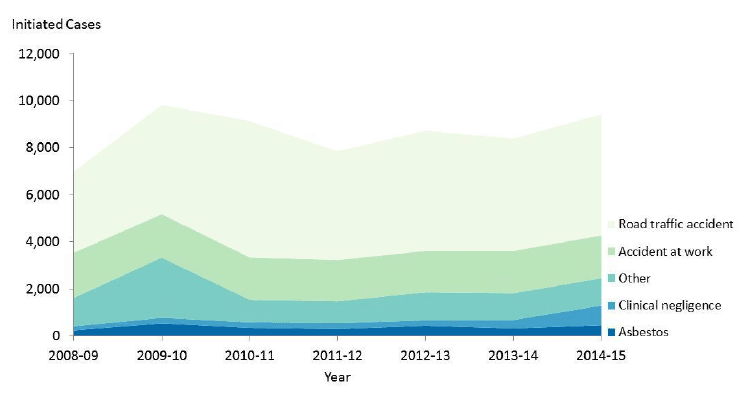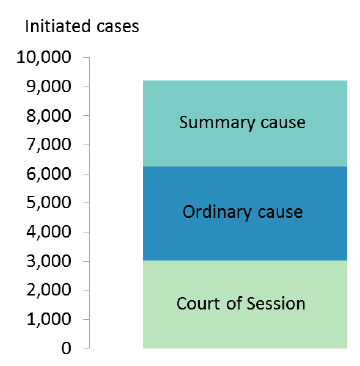Civil justice statistics in Scotland: 2014-2015
The 2014-15 Civil Justice in Scotland release includes: 1. MAIN STATISTICS TABLES (compromising tables that appear in this bulletin) 2. DIVORCE & DISSOLUTION STATISTICS TABLES (further breakdowns on divorce & dissolution) 3. SUPPLEMENTARY STATISTICS TABLES (additional statistics on civil law cases in sheriff courts and the Court of Session) 4. BACKGROUND DATA TABLES (an interactive dataset on civil law court cases by court, that can be used to generate user customised tables and charts)
This document is part of a collection
7. Personal injury
There was a 11 per cent increase in personal injury cases in 2014-15 compared to 2013-14
A third of personal injury cases were raised in the Court of Session where they made up 79 per cent of the cases in the General Department
Over half of personal injury cases were in relation to a road traffic accident
Personal injury in Scotland
Personal injury can be physical and/or psychological, and include disease or impairment. Personal injuries may result from a wide range of causes including an injury received at work, a traffic accident or through negligence or a deliberate act on the part of another party. A person who has suffered an injury can seek redress through several routes, such as making a complaint against the person/organisation they consider to be responsible for the injury, seeking assistance with any financial problems they have as a result of their injury or seeking counselling. Alternatively, they may wish to claim compensation, provided certain criteria are met to cover losses they have suffered as a result of the injury. A claim for compensation can be made using a claims assessor or by taking legal action in a civil court and, if successful, would result in a payment of damages being awarded.
A personal injury case is a form of damages case that relates specifically to damages for, or arising from, personal injuries or the death of a person from personal injuries. Personal injury actions do not cover defamation or any actions which are not commonly understood to be concerned with personal injuries. Such actions are covered in the Damages chapter of this bulletin.
Personal injury cases made up 12 per cent of all civil court cases initiated in 2014-15.
Scottish Crime and Justice Survey
In the 2014-15 Scottish Crime and Justice Survey, one per cent of respondents experienced a medical negligence issue and two per cent experienced a personal injury problem in the last three years. The prevalence of experiencing at least one of these two issues were higher for those who were victims of crime (five per cent) in contrast to non-victims (two per cent).
Courts
The 9,210 personal injury cases initiated in 2014-15 was 11 per cent higher than 2013-14, however, historically the number of personal injury cases has fluctuated considerably. The increase was greatest in the Court of Session where personal injury cases rose by 20 per cent compared to 2013-14. Personal injury cases account for a considerable proportion of the cases in the Court of Session. However, the type of court where personal injury cases are raised is expected to change under the Courts Reform Act, see section on Court of Session in Chapter 4.
As in every year since 2008-09, cases resulting from a road traffic accident made up the greatest proportion of personal injury cases, accounting for 56 per cent in 2014-15. There was an increase of eight per cent of these personal injury cases from 2013-14 to 2014-15 (Figure 14 and Table 13). This compares to a seven per cent decrease from 2012-13 to 2013-14. This fluctuation in road traffic accident related cases is in contrast to the downward trend in the number of reported road traffic accident casualties[7].
Figure 14: Personal injury cases by case types

For the second year running, there was a large increase in clinical negligence cases, up 140 per cent from 262 cases in 2013-14 to 629 cases in 2014-15. In the Court of Session, where 87 per cent of clinical negligence cases were raised, the increase was even greater at 224 per cent from 168 cases in 2013-14 to 545 cases in 2014-15. The rise in these cases is thought to be related to compensation claims associated with mesh implants and breast implants (Figure 14).
In 2014-15 there was also a rise in the number of asbestos cases, increasing by 43 per cent compared to the previous year to 458. However, this is still lower than the peak of 541 cases initiated in 2009-10. The peak in 2009-10 can be explained in part by the introduction of the Damages (Asbestos-related Conditions) (Scotland) Act 2009, which came into force in June 2009 and allows individuals with asbestos-related pleural plaques etc. to raise a court case for personal injury (Figure 14 and Table 13).
Many asbestos cases were sisted (suspended) pending the UK Supreme Court's decision as regards a judicial review of the Damages (Asbestos-related Conditions) (Scotland) Act 2009. Following the decision of the UK Supreme Court dated 12 October 2011 in the case Axa General Insurance Ltd & Others v The Lord Advocate, direction no. 2 of 2012 was made by the Lord President on 27 August 2012 outlining the procedures to be followed in the relevant cases and disposals have since progressed accordingly.
Although the percentage increases in clinical negligence and asbestos cases initiated were large, the proportion of personal injury cases that they account for is still relatively small at seven and five per cent respectively (Figure 14).
Across all categories of personal injury cases in the Court of Session, absolvitor was the most common disposal accounting for nearly two-thirds of all cases disposed. Absolvitor means the pursuer is prevented from bringing the same matter to court again, but in some of these cases the parties involved would have come to an out-of-court settlement (Table 14).
In 2014-15, personal injury actions were split roughly equally between Court of Session, sheriff court Ordinary procedure and sheriff court Summary Cause procedure (Figure 15).
Figure 15: Personal injury case types by procedure, 2014-15

Contact
Email: Eddie Chan
There is a problem
Thanks for your feedback